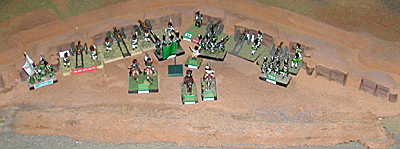 Here's a twist. At most conventions, I usually hang around the dealer area and walk around the gaming areas, missing the lectures.
Here's a twist. At most conventions, I usually hang around the dealer area and walk around the gaming areas, missing the lectures.
The Great Redoubt
At Borodino 2002, the reverse happened. I caught most every talk, but missed most of the simulation. Although I did walk and talk around from time to time, pardon my overview--I was not privy to the tactical details on every turn.
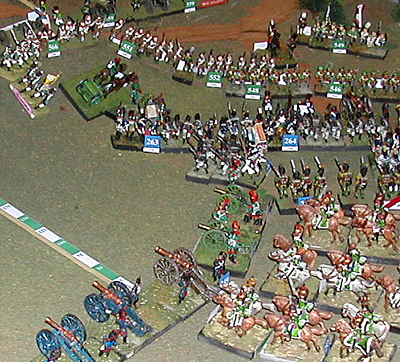 French face off against Russians, while French cavalry hold behind the artillery.
French face off against Russians, while French cavalry hold behind the artillery.
Still, without going into detail, I can give you the gist of the battle. Napoleon decided to pull a right flank maneuver, sending Davout on a march around. The left flank would demonstrate and the center would hold back, waiting for the flank march to arrive.
The Russians decided to pull back and give ground, bloodying the French nose at every opportunity as long as it allowed the army to remain intact. As a result, the Shevadino redoubt was abandoned, although the town of Borodino was held for a while with a stubborn rearguard.
The French left flank, consisting mainly of cavalry, raced forward, pressing back the Cossacks across the river. Not that they went easily, for Almet Ilman, the Russian Cossack commander, who had come all the way from his home in Turkey for the event, fell back stubbornly and launched sharp counterattacks. He still fell back, and ended up along the river. Additional forces supported him, and the French, though they made a foray across a ford from time to time, remained quiet.
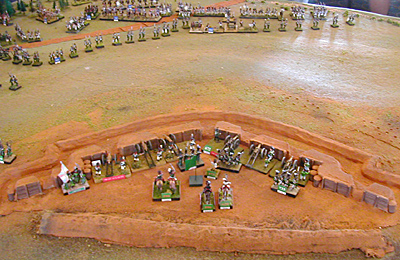 In the middle, the Russians fell back to the Great Redoubt (photo at right: here come the French!) and the Fleches. Here, tremendous battles were fought towards the later stages of the game, as the Great Redoubt, true to history, fell to the French, who were then driven out by the Russians, who were consequently thrown out by the Poles, who were tossed out by the Russians, and so on.
In the middle, the Russians fell back to the Great Redoubt (photo at right: here come the French!) and the Fleches. Here, tremendous battles were fought towards the later stages of the game, as the Great Redoubt, true to history, fell to the French, who were then driven out by the Russians, who were consequently thrown out by the Poles, who were tossed out by the Russians, and so on.
Some overexcited French overextended themselves between hill and forest, and were counterattacked sharply. At one point, the French center looked like it would cave in, but re-inforcements came to the center's aid.
On the right, the French drove through the woods, eventually isolating a Russian division towards the center. The Russians, true to plan, resisted but continued to give ground. At about this time, Davout made his appearance and started to drive the flank inward. That's when things got really interesting.
The attack, led by French cavalry, met the Russian cavalry reserve while the Russians frantically tried to pull out troops and set up a line. The Russian cavalry did its job, although at great cost, and tossed the French cavalry back, forcing the infantry to form square and grinding the attack to a temporary halt. It bought time to bring out more units, though not the surrounded division in the woods.
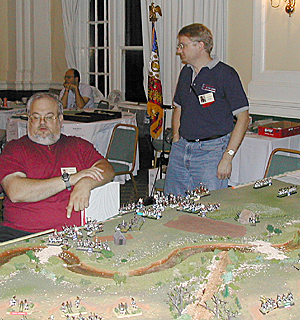 French cavalry commanders rein in their troops on the left flank. In the background, Napoleon plots...
French cavalry commanders rein in their troops on the left flank. In the background, Napoleon plots...
Eventually, the French surged forward again, battering the Russians as they went, but not enough to surround the center.
Meanwhile, off to the left flank, Ahmet the Fighting Turk pulled his own version of a flank march with just about all the remining Cossack cavalry. It was a major surprise to the French, who were outnumbered something like 10:1 and were trying to gather reserves to halt the envelopment.
It was at about this time late on Saturday night that the simulation ended. Something like 35-40 turns had been played, all of them funneled through the ever-patient computer operators who typed in the various commands and unit stats to coordinate firing, morale, and so on, and then implement the results.
At one part of the game, Norbert (Napoleon) played French marching music at top volume out of his boom box, grabbed a French flag, and waved it madly while his commanders cheered "Vive la Empereur!" As he put it later during the Awards Banquet on Sunday morning: "It didn't mean anything. Complete Psy-ops!"
After Action Reports
From Tom Ballou (Umpire):
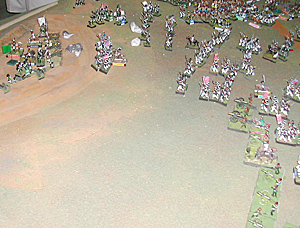 On the way back to DC, Pete and I had about 3 hours to discuss & dissect
the battle. It seems to us (or me, correct me if I'm wrong on this Pete)
that the difference from a French Major Victory and the French Minor
Victory was the Great Redoubt.
On the way back to DC, Pete and I had about 3 hours to discuss & dissect
the battle. It seems to us (or me, correct me if I'm wrong on this Pete)
that the difference from a French Major Victory and the French Minor
Victory was the Great Redoubt.
The initial French surge against the Russian Great Redoubt.
If the commander had demonstrated as instructed by Norbert, the French would have had a reserve Corps to commit. This Corps could have been committed to the Flechettes, that had fell apart by the end of the game.
That reserve Corps's commitment to that board would have
precipitated a break through, much earlier, and closed the door on all the
forces behind Utitsa, being the Anvil to the right hook's Hammer. With the
cracking of the Flechetts, the Guard Cavalry could have been committed to the
break through and closed the door on the rear of the Great Redoubt (if they
one the battle with the Russian Cav reserve) and move towards the Russian
LOC.
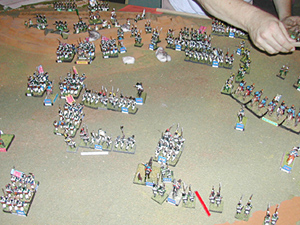 So close! The French storm the Redoubt for a short time.
So close! The French storm the Redoubt for a short time.
Now whether the timing of all this was possible, I don't know. But clearly, the forced commitment of the on table reserves to the meat grinder that was the Great Redoubt, removed the options (and any chance) the French had to deliver the killing blow.
Of course the other factor to consider is the
forces behind the Great Redoubt, would not have been committed to a fight
if the French did not press them, so they could have pull out and back to
deal with the encirclement threat, so timing of the actual assault on the
Great Redoubt would have been critical too.
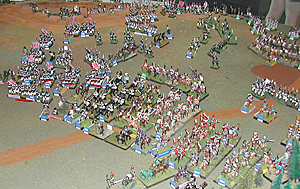 The French press forward!
The French press forward!
Over all I was very impressed with both sides plans, the Russians clearly knew, what they had to accomplish and what to avoid. The French had a good plan, and executed the flank assaults with Úlan.
I wish we had more time to deal with the withdrawal of the Russians, could the forces in the Great Redoubt pull back in time to prevent encirclement and destruction? I'm not sure - their blood was up, and they where charging forward, a pull back would be very hard to execute.
From Tom Cusa (Umpire):
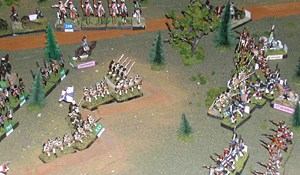 As the GM on site with the flechettes I just wanted to make a few comments on
Tom's observations/suggestions.
As the GM on site with the flechettes I just wanted to make a few comments on
Tom's observations/suggestions.
I don't know if an extra French reserve corps committed on that board could have made much of a difference expect as part of a future game (possibly coming to Fall In, stay tuned folks).
The biggest problem faced by the French in the flechettes (see at right) was traffic control. Except for their civil improvement project of building that bridge through the forest and over the ravine they were faced with a narrow bottleneck in which to deploy. If the French had sent more infantry or the guard cavalry onto that board they would have had very little room to maneuver except to follow up the French breakthrough that was already occurring.
The French planned for and were executing a textbook breakthrough with the better part of the Italian Division as the game ended. More troops would have enabled them to push harder on the Russian right, but until army morale started kicking in they were still staring at a tired but unhurt line of 3 batteries on that flank and they did not know what was waiting for them behind that hill. As it turned out there was a reinforced division behind that hill.
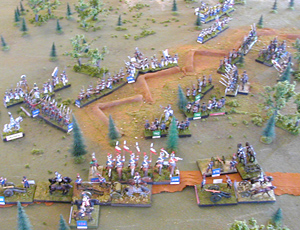 Flechette action continued.
Flechette action continued.
A hard push from the French before the actual push came would have been very bloody, but could possibly have broken the army morale that much sooner. The final factor would have come down to the issue of timing that Tom mentioned.
Any new troops sent by Napoleon to the Flechettes would have spent several turns working their way through the traffic jam on that board. Duke Constantine however had plenty of Guardsmen ready to jump into either the Great Redoubt or the Flechettes and they could have deployed freely in plenty of time to receive the Frenchmen.
The most important point I am trying to make is that the French on the Flechettes board played their "A" game that weekend. They moved up, attacked and waited patiently for their best opportunity to exploit a break in the lines. I honestly did not want to nominate a best French player on my board because they were a seamless machine who each played their role excellently. (Also most of them were named Bob, which made the choice more difficult as well).
More troops sent to the Flechettes board would have enabled the French to make more of the breakthrough when it came, but I do not think it would have made the breakthrough come sooner than it did.
From Scott Monteith
 Most of the AAR will be on the Russian held Flechettes since my other
command didn't see action until last gaming period.
Most of the AAR will be on the Russian held Flechettes since my other
command didn't see action until last gaming period.
Mid game action somewhere on the front lines.
Opening of battle saw IV Russian Corp in front of the Flechettes and only the artillery of the VI Corp in the flechettes with one art. battery in reserve. The French on F1 across from us did not move forward for most of the gaming first period and as a result the IV Corp started to fall back to the hill and flechettes to the Russian left. French finally started their advance when IV Corp started their fall back. Some artillery was fired on both sides with little damage.
Second period saw more advance of the French,who turned out to be the 4th Corp of Eugene w/Italian guard. This Corp was larger than our VI & IV Corps combined and they had 2 Cav Corp(4th & 6th) within the 4th Corp. The Russian Corps had no cavalry at all which would give us a great disadvantage in the ensuing conflict as it unfolded. The Russian IV Corp did manage to withdraw to the Russian left with the jagars taking the woods to the extreme left and forward. The VI Corp now filtered in most of the 7th division to the flechettes keeping the whole 24th div. and 2 artillery batteries in reserve on the reverse slop, unknown to the French.
Third period (Friday pm) saw more artillery action on both sides plus small arms action in the woods to our left(jagers and French inf.). As the French advanced so did their artillery which we could do nothing to stop or even threaten unless we used our artillery which was used more for inf. and cav. targets. We requested cavalry support which was denied, orders were to hold area till the end with what you have. As the French advanced to take the flechettes and started to engage the Russians the entire 24th div now showed themselves much to the surprised French.
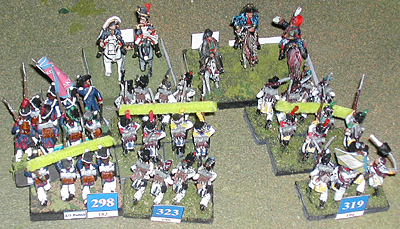 Napoleon himself trying to rally dispirited French troops somewhere in the rear area towards the end of the battle.
Napoleon himself trying to rally dispirited French troops somewhere in the rear area towards the end of the battle.
Fourth period had continued heavy fighting in the woods to our left with the French slowly gaining ground, and French advancing toward the Russian IV Corp on the hill left off Russian VI Corp. Time was right for counter attack in the flechettes now in French hands, I figured they were very fatigued. I attacked with only 2 battalions of line inf. in column and as a result each pushed back 2 French battalions. The next turn I again attacked with same 2 battalions, one was stopped due to artillery fire but the other went through 3 more French battalions. This worked very well as to make the attack on the Russian right an non-issue. That forward battalion did die but it took 2 cav charges and an inf. attack over the next 3 turns to destroy it.
On the IV Corp side several of their artillery stopped any and all French attacks, one battery stopped no less than 3 cavalry charges! Period 5, I left to command Pahlen-III Cav Corp who with all the Cossacks were attacking the French extreme left in the rear or F2 table. Pahlen's command like the 24th was fresh and ready to do combat. The time of day however did play into the results, after one charge the battle cav. was hard to order for follow-up charges. The Russian cav. and Cossacks did their job and damaged the French very much on F2 table. I looked at the Flechettes near the end at which time the Russians were pulling back with much of VI Corp still intact but IV Corp was hardy left, this as a result of continued artillery fire at closer range since the French had a ton of artillery and could move it up closer with no threat of cavalry. The French never got off the Flechettes table and there was still some fight left in the Russians if they continued. In the end both sides lost about 8,000+ men on C-2 table. The C-2 table held out for the game even when C-1 was lost to the French and R-1 was losing to the French push in the table to our rear.
From Nigel Marsh (Chief Tactical Umpire):
I was able to combine all the individual orders of battle into one 'grand' OoB, with the following results:
Pyhrric Victory for the Grande Armee
The Grande Armee has suffered losses of:
[ 28%] 33931 men of all arms
incl.[ 5%] 6605 prisoners of all arms
5 standard[s] lost
112 cannon[s] lost
Honors: [ 193] 2/108me Ligne
[ 30%] 24826 bayonets
[ 27%] 7038 sabres
[ 17%] 2067 artillerists
The Russian Army has suffered losses of:
[ 30%] 33331 men of all arms
incl.[ 8%] 9181 prisoners of all arms
9 standard[s] lost
200 cannon[s] lost
Honors: [ 658] CP Dennisov #5
[ 30%] 21572 bayonets
[ 33%] 7441 sabres
[ 27%] 4318 artillerists
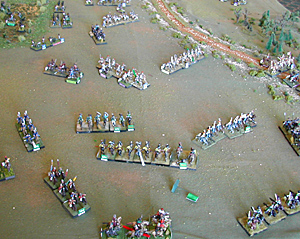 Ahmet's Cossacks as they storm into the French rear.
Ahmet's Cossacks as they storm into the French rear.
Interestingly the casualties are only 600 men in difference in favor of the French. However, the French suffered more dead and wounded, when you subtract the numbers of missing and prisoners.
It is interesting to see that the 'computer' also favored Ahmet as the most feared Russian player - I believe he was commanding [658] CP Dennisov #5. Whilst the French armies most 'valiant' unit belonged to Dessaix's division of I Corps.
More Borodino 2002 Napoleonic Conference
- Welcome, Introduction, and the Hotel Chamberlain
Borodino Ballroom
MagWeb.com Napoleonic Speakers Conference
Friday Lecture: Bob Coggins: Napoleonic Unit Frontages and True Linear Scale
Friday Lecture: Frank Chadwick: The Russian Army at Borodino
Friday Lecture: Jean Lochet: Preparation of French Cavalry for Campaign of 1812
Friday Tour: Fort Monroe Casemate Museum
Friday Keynote Lecture: Dr. William J. Gregor: Long Shadow of Napoleon on American Military Planning
Friday Lecture: Jean Lochet: The Attempt to Rebuild the French Cavalry for 1813
Saturday Lecture: Kevin Zucker: The French Army of 1812
Saturday Lecture: Dr. James H. Birdseye: Glory or Shame? The Role of Morale on the Napleonic Battlefield
Saturday Lecture: Dr. George Nafziger: Prelude to 1812: The 1809 Campaign in Poland
Special Guest: Lt. Col. Andrey Pavlov: Deputy Military Attache from the Russian Embassy
Saturday Lecture: Glenn Drover: Napoleonic Game Design and Production
Saturday Lecture: Jean Lochet: The Peace Conference of Prague: Negotiations with Napoleon During the 1813 Armistice
Video Presentation: Dr. Ben Weider: Borodino Re-enactment 1997
Video Presentation: Austerlitz and Sharpe
Re-enactor Presentations: Russians and French
Borodino: The Wargame
Side Wargames: Survivor, et al.
Awards Banquet
Back to List of Conventions
Back to Travel Master List
Back to MagWeb Master List of Magazines
© Copyright 2002 by Coalition Web, Inc.
This article appears in MagWeb (Magazine Web) on the Internet World Wide Web.
Other military history articles and gaming articles are available at http://www.magweb.com